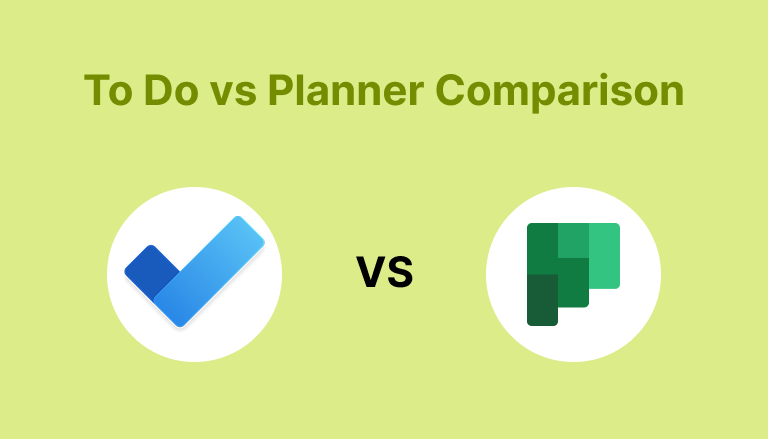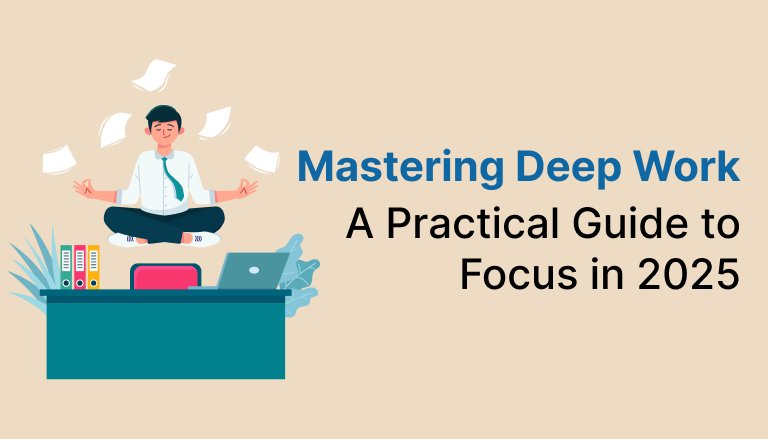In a world of constant pings, open tabs, and shifting priorities, sustained focus has quietly become a competitive advantage. The concept of deep work—uninterrupted, cognitively demanding effort—was once a luxury. Today, it’s a necessity.
According to research, the average knowledge worker is truly productive for just 2 hours and 53 minutes each day. The rest of the time is often lost to context switching, shallow tasks, and distractions that fragment attention and drain creative energy.
The problem runs deeper: Research shows that 60% of employees’ time is spent on work about work—status updates, meetings, emails—leaving little room for focused execution. Meanwhile, data found that nearly 90% of U.S. workers are distracted daily, with 1 in 4 interrupted more than six times during their workday.
These numbers point to more than just inefficiency—they highlight a growing disconnect between how we work and how we want to work.
So how do you reclaim time for meaningful progress? How do you re-engineer your schedule, space, and mindset to support deep, focused efforts?
To answer that, we’ll first explore the philosophy of deep work, then unpack the barriers that prevent it—and finally look at techniques and tools that can help you build a sustainable deep work habit.
The Philosophy of Deep Work
Coined by author and professor Cal Newport, deep work refers to:
“Professional activities performed in a state of distraction-free concentration that push your cognitive capabilities to their limit.”
In contrast, shallow work includes low-effort, easily replicated tasks — like replying to emails or attending routine meetings. Both have their place, but only deep work leads to meaningful progress, faster learning, and higher-quality results.
Deep work doesn’t happen by accident. It must be cultivated deliberately, especially in a culture that rewards constant availability and multitasking.
Newport outlines four ways to structure deep work:
- Monastic: Fully eliminate distractions for extended periods
- Bimodal: Set aside full days for deep work alongside regular ones
- Rhythmic: Create a daily deep work habit (e.g., same time each day)
- Journalistic: Fit deep work into open time slots with discipline
Each approach works — but only with intentional boundaries and protected time. The more consistently you work deeply, the more your skills, clarity, and output compound over time.
So what stops most people from doing it? Let’s explore the barriers next.
Common Barriers to Deep Work
If deep work delivers so much value, why is it so hard to consistently practice?
The reality is that modern work environments are not designed for focus. In fact, they often reward the opposite — quick responses, constant availability, and the ability to juggle a dozen things at once.
Here are some of the most common friction points professionals face when trying to prioritize deep work:
- Always-On Digital Culture: Slack pings, email dings, app alerts — it only takes one notification to break your flow. Studies show it takes an average of 23 minutes to return to a task after an interruption.
- Unstructured Workdays: Without a system to prioritize deep work, shallow tasks like meetings and quick asks take over—urgent but not always important
- No Clear Ending Point: In remote or hybrid setups, lack of boundaries keeps the brain in reactive mode without clear shutdown rituals.
- Tool Overload: Ironically, many people turn to multiple productivity apps hoping to gain control — but end up managing the tools more than the tasks.
Recognizing these patterns is the first step toward addressing them. The good news? These are solvable problems — not personality flaws. Now, we’ll explore how to reframe your day and introduce strategies that make deep work a repeatable, sustainable habit — not a once-in-a-while achievement.
Building a Deep Work Routine (That Actually Sticks)
You don’t need monk-like discipline to benefit from deep work. What you need is a repeatable structure — a system that helps you shift into focus mode without overthinking it.
If distractions are the default, then deep work must be the design. Here’s how to start building a deep work routine that fits your real life, not just your ideal week.
1. Create a Simple Planning Ritual
Start each morning (or the night before) by asking:
- What are the 1–2 cognitively demanding tasks I must complete today?
- When will I realistically do them?
This takes less than 10 minutes and serves as your anchor for the day — turning deep work from an abstract intention into a time-blocked reality.
2. Schedule Deep Work Like a Meeting
Don’t just “try to get to it.” Block it on your calendar like you would for a call — and honor it the same way. Even 60 to 90 minutes of protected focus can produce outsized results.
Start small if needed. Consistency matters more than duration in the beginning.
3. Design for Zero Distractions
During your deep work block:
- Turn off notifications (yes, all of them)
- Put your phone out of reach
- Use a full-screen window or dedicated space
- Inform your team you’re in focus mode if needed
4. Use a Pre-Work Checklist
Before diving in, set up your workspace with:
- A clear task or deliverable
- Any required reference material open
- A water bottle, headphones, or timer nearby
This pre-focus ritual trains your brain to associate these cues with entering “deep mode.”
5. Wrap Up and Reset
At the end of your deep work session:
- Jot down what you accomplished
- Note what needs follow-up or finishing
- Close open tabs or materials to clear your mental cache
This small reset makes it easier to switch back to lighter tasks — and primes you for deeper focus next time.
Now that you’ve got a structure in place, the next question is: can your tools keep up?
Tools That Support Deep Work (Without Becoming a Distraction)
The best tools for deep work aren’t the flashiest. They’re the quiet ones — the ones that reduce friction, limit decision fatigue, and help you stay in flow without making you manage yet another system.
If your current productivity setup feels like juggling tabs and inboxes instead of guiding your day, it may be time to rethink your tool stack.
Here are some types of tools (with examples) that align well with a deep work mindset:
1. Time Blocking Tools
For people who plan their days hour by hour, a time-blocking interface helps convert intentions into actual focus time.
- Akiflow blends task capture with calendar-based planning, allowing you to drag and drop tasks directly into your schedule.
- Sunsama encourages a mindful daily planning ritual where you pull in tasks and block time for them.
- Google Calendar (when paired with a consistent habit) can work just fine for visual planners.
What matters more than the tool is how easily it lets you protect time for deep work — and reschedule it without chaos when priorities shift.
2. Unified Task Inboxes
The fewer places you need to check, the better. Look for tools that let you consolidate tasks from email, Slack, Notion, or other sources into a single inbox.
- Akiflow, again, is helpful here. It pulls in tasks from your connected apps so you’re not manually rewriting your to-dos all day.
- Motion and Notion (with advanced setups) can be configured for similar workflows.
- For simple use cases, Todoist with email forwarding might be enough.
A unified inbox clears mental clutter and lets you start your day from a single command center, not a dozen tabs.
3. Distraction-Limiting Apps
Protect your deep work sessions by blocking interruptions before they start.
- Freedom and Cold Turkey block websites and apps across devices.
- Brain.fm and Endel provide focus-enhancing music backed by neuroscience.
- Forest gamifies staying off your phone during focus sessions.
These apps aren’t mandatory — but even using one consistently can create a powerful boundary around your deep work blocks.
4. Choose Tools That Fit (Not Fight) Your Flow
No tool will make you focused — but the right one will make it easier to stay that way. Whether you prefer pen and paper or digital dashboards, choose something that supports your routines, rather than reshaping your workflow to fit the tool.
But setting up the right tools is just the first step. Staying consistent — day after day, week after week — is where the real payoff happens.
Let’s look at how to make deep work a lasting habit, not just a one-week experiment.
Sustaining Deep Work Over Time
The real challenge with deep work isn’t starting — it’s sticking with it.
Anyone can block 90 minutes on a quiet Tuesday. But doing it consistently, even when your schedule is chaotic, your energy is low, or your motivation dips? That’s where deep work moves from a tactic to a habit.
Here are a few ways to make that shift:
1. Anchor It to a Time or Trigger
Consistency is easier when deep work happens at the same time each day or follows a predictable trigger (like right after your morning coffee or after checking emails).
Think of it like a workout: if it’s always on the calendar, your brain stops negotiating.
2. Mix Deep and Shallow Work Mindfully
Not every hour needs to be deep. That’s not the point. Instead, be deliberate about when you’re doing shallow work — replying to emails, attending meetings, logging expenses — and don’t let it bleed into your focus blocks.
Batching shallow tasks into dedicated slots creates mental boundaries that protect your focus time.
3. Reflect Weekly — Not Just Daily
Daily planning is important, but weekly reviews help you zoom out and spot patterns:
- Which tasks keep getting pushed?
- Which sessions felt productive vs. drained?
- Where did distractions creep in?
Use this insight to tweak your schedule — not to aim for perfection, but to learn what supports your best work.
4. Redefine “Success”
Not every deep work session has to end with a big outcome. Sometimes, success is just showing up and doing the thing you said you would — especially when it’s hard.
The key is to build the habit first, then refine the results over time.
Speaking of which, let’s wrap up with a few thoughts on how to make deep work feel not just doable — but essential.
Conclusion: Make Deep Work a Daily Practice
Deep work isn’t a productivity trend — it’s a core skill for doing meaningful work in a distracted world. But it takes more than willpower. It takes structure, consistency, and the right setup.
If you’re looking for a tool that helps you plan with intention, block time for focus, and pull tasks from all your tools into one place, Akiflow is built for that.
Try Akiflow free and turn deep work from a goal into a routine.

Getting Things Done in 5 Steps: The Secret to Mastering Your Workflow
Master your workflow with the Getting Things Done method. Discover 5 simple steps to stay organized, reduce stress, and boost productivity.

Microsoft To Do vs Planner: Which Task Management Tool Is Right for You?
Compare Microsoft To Do vs Planner. Discover ideal scenarios for task management and team collaboration. Choose the right tool and boost productivity today!

Best Task Management Tools and Techniques for 2025
Boost efficiency with task management tools like ClickUp and Trello. Choose the right tool for your team, improve productivity, and reduce burnout. Explore now!
